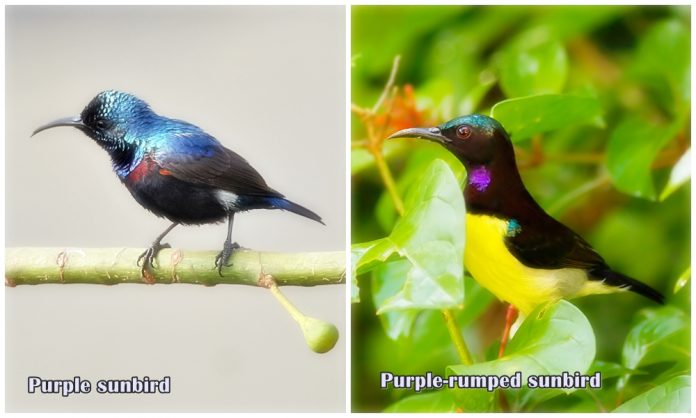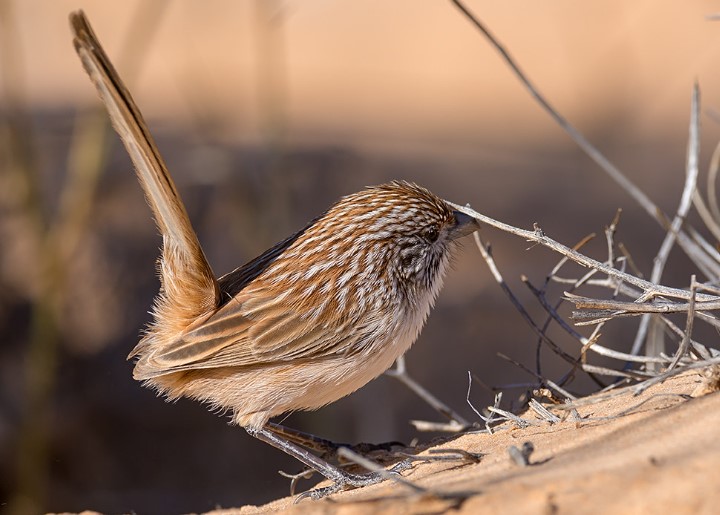Many bird lovers are interested to know about the difference between Purple Sunbird vs Purple-rumped Sunbird. Both are tiny and colorful birds. In this post, we will try to identify the difference between two sunbird species.

Purple-rumped sunbird (Leptocoma zeylonica)
Unlike many hummingbird species, sunbirds have brightly colored, sometimes iridescent feathers. The tongue of the sunbird is covered with bristles and it has a thin, downward curving bill. The males and females of these species display sexual dimorphism, which means that they are different in color.
Generally, the coloration of the males is more distinguishable. Purple-rumped Sunbirds (Leptocoma zeylonica) exhibit a variety of beautiful colors. Approximately 10 cm in length, purple-rumped sunbirds are tiny birds.
Adapted for feeding on nectar, their long, thin, down-curved bills and moist-tipped tubes are both perfect for feeding on nectar. It is active during the daytime and lives in pairs or small groups. When the breeding season is in full swing, they aggressively defend their territories.
Several metallic green colors adorn the crown and shoulder patch of the male, as well as dark brown underparts, a whitish flank, a purple rump, and a yellow throat.
Female Purple-rumped Sunbirds are pale yellow above and light grayish-brown below. Uppersides of females are olive to brownish and uppertail coverts are black; a weak supercilium may be seen. Male Purple-rumped Sunbirds can be distinguished from female Purple Sunbirds by their grayish-white (not yellow) throats.
The males have deep maroon uppersides and a blue-green crown with gleaming edges, bright green shoulder patches, and violet rump patches that are hidden beneath the wings. During the monsoon season, purple-rumped sunbirds lay two broods and breed throughout the year.
The nest has an exterior studded with bark pieces, lichens, flying seeds, and other materials, and is made from fine plant fibers, cobwebs, and other materials. Females construct nests alone, although males may accompany them.
Purple-rumped Sunbirds are often hovering about picking up insects and flowers for nectar. It is possible for them to visit crops and eat honeydew released by leafhoppers. It is often tweeting “tityou, tityou, trritt, tityou.” is the song’s climax. This species breeds most commonly in the southern parts of India, Sri Lanka, Pakistan, and Bangladesh.
Purple sunbird (Cinnyris asiaticus)
Usually found in Southeast Asia, the purple sunbird (Cinnyris asiaticus) extends westward into parts of the Arabian Peninsula. They also eat insects, especially when feeding young sunbirds, but they mostly rely on nectar.
In addition to its short bill and short tail, the purple sunbird has a distinctive male-to-female sexual dimorphism. The bird is not more than 10 cm in length, with a down-curved bill and brush-tipped tube tongue that help it in feeding on nectar.
A wide range of Purple Sunbirds can be found from West Asia through southern Asia and into Southeast Asia. The birds do not move long distances in most parts of their range, as most of their territory is occupied by residents.
Their habitats include thin forests and garden land, including urban areas that are densely populated. The local movements are noted most prominently in the drier parts of northwestern India and Pakistan, where large numbers are believed to have arrived before summer.
A fast and direct flight characteristic, they can hover over flowers to collect nectar, but they tend to perch at the bases of flowers. When the males are exposed to harsh sunlight, they appear all black, but the purple iridescence can be seen on closer inspection and under better lighting conditions.
Females are olive-colored above and yellow-colored below. The Female has the yellow color of the breasts and the throat becomes paler toward the vent. Both males and females have white tips on the outer tail feathers However, the Male appears blue-purple-black on their upperparts with dark brown wings.
This species can be confused with the syntopic Loten’s sunbird in its breeding plumage. It is distinguished by the broad, maroon band on its breast and the long bill. Occasionally, breeding males will display tufts on their pectorals. Breeding males possess a patch of bright blue color on their shoulders.
A purple sunbird is very vocal, joining mobs of owls and other predators with their cries. Using rapid rattles and metallic tones, the song’s melody follows. The “chwit” or “chwing!” is another type of call note. Males raise their heads, flutter their wings partially open to show off their pectoral tufts, and sing during courtship displays. The pouches of nests are made from cobwebs, thin strips of vegetation, lichens, and the bark itself.
Read More – Yellow-bellied Sunbird (Cinnyris jugularis)







